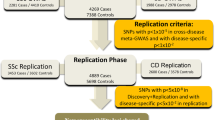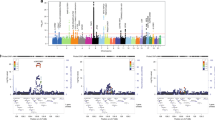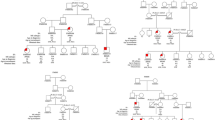Abstract
There is a strong and complex genetic component to multiple sclerosis (MS). In addition to variation in the major histocompatibility complex (MHC) region on chromosome 6p21.3, 110 non-MHC susceptibility variants have been identified in Northern Europeans, thus far. The majority of the MS-associated genes are immune related; however, similar to most other complex genetic diseases, the causal variants and biological processes underlying pathogenesis remain largely unknown. We created a comprehensive catalog of putative functional variants that reside within linkage disequilibrium regions of the MS-associated genic variants to guide future studies. Bioinformatics analyses were also conducted using publicly available resources to identify plausible pathological processes relevant to MS and functional hypotheses for established MS-associated variants.
This is a preview of subscription content, access via your institution
Access options
Subscribe to this journal
Receive 6 digital issues and online access to articles
$119.00 per year
only $19.83 per issue
Buy this article
- Purchase on Springer Link
- Instant access to full article PDF
Prices may be subject to local taxes which are calculated during checkout

Similar content being viewed by others
References
Oksenberg JR, Barcellos LF . Multiple sclerosis genetics: leaving no stone unturned. Genes Immun 2005; 6: 375–387.
Hawkes CH, Macgregor AJ . Twin studies and the heritability of MS: a conclusion. Mult Scler 2009; 15: 661–667.
Hemminki K, Li X, Sundquist J, Hillert J, Sundquist K . Risk for multiple sclerosis in relatives and spouses of patients diagnosed with autoimmune and related conditions. Neurogenetics 2009; 10: 5–11.
Sawcer S, Hellenthal G, Pirinen M, Spencer CC, Patsopoulos NA, Moutsianas L et al. Genetic risk and a primary role for cell-mediated immune mechanisms in multiple sclerosis. Nature 2011; 476: 214–219.
Beecham AH, Patsopoulos NA, Xifara DK, Davis MF, Kemppinen A, Cotsapas C et al. Analysis of immune-related loci identifies 48 new susceptibility variants for multiple sclerosis. Nat Genet 2013; 45: 1353–1360.
Patsopoulos NA, Barcellos LF, Hintzen RQ, Schaefer C, van Duijn CM, Noble JA et al. Fine-mapping the genetic association of the major histocompatibility complex in multiple sclerosis: HLA and non-HLA effects. PLoS Genet 2013; 9: e1003926.
Gregory SG, Schmidt S, Seth P, Oksenberg JR, Hart J, Prokop A et al. Interleukin 7 receptor alpha chain (IL7R) shows allelic and functional association with multiple sclerosis. Nat Genet 2007; 39: 1083–1091.
Gregory AP, Dendrou CA, Attfield KE, Haghikia A, Xifara DK, Butter F et al. TNF receptor 1 genetic risk mirrors outcome of anti-TNF therapy in multiple sclerosis. Nature 2012; 488: 508–511.
Ward LD, Kellis M . HaploReg: a resource for exploring chromatin states, conservation, and regulatory motif alterations within sets of genetically linked variants. Nucleic Acids Res 2011; 40 (Database issue): D930–D934.
Abecasis GR, Auton A, Brooks LD, DePristo MA, Durbin RM, Handsaker RE et al. An integrated map of genetic variation from 1,092 human genomes. Nature 2012; 491: 56–65.
Kumar P, Henikoff S, Ng PC . Predicting the effects of coding non-synonymous variants on protein function using the SIFT algorithm. Nat Protoc 2009; 4: 1073–1081.
Ramensky V, Bork P, Sunyaev S . Human non-synonymous SNPs: server and survey. Nucleic Acids Res 2002; 30: 3894–3900.
Zhang B, Kirov S, Snoddy J . WebGestalt: an integrated system for exploring gene sets in various biological contexts. Nucleic Acids Res 2005; 33 (Web Server issue): W741–W748.
Schaub MA, Boyle AP, Kundaje A, Batzoglou S, Snyder M . Linking disease associations with regulatory information in the human genome. Genome Res 2012; 22: 1748–1759.
Manolio TA, Collins FS, Cox NJ, Goldstein DB, Hindorff LA, Hunter DJ et al. Finding the missing heritability of complex diseases. Nature 2009; 461: 747–753.
Cooper GM, Shendure J . Needles in stacks of needles: finding disease-causal variants in a wealth of genomic data. Nat Rev Genet 2011; 12: 628–640.
Brustle A, Brenner D, Knobbe CB, Lang PA, Virtanen C, Hershenfield BM et al. The NF-kappaB regulator MALT1 determines the encephalitogenic potential of Th17 cells. J Clin Invest 2012; 122: 4698–4709.
Macian F . NFAT proteins: key regulators of T-cell development and function. Nat Rev Immunol 2005; 5: 472–484.
Stittrich AB, Haftmann C, Sgouroudis E, Kuhl AA, Hegazy AN, Panse I et al. The microRNA miR-182 is induced by IL-2 and promotes clonal expansion of activated helper T lymphocytes. Nat Immunol 2010; 11: 1057–1062.
Baumjohann D, Ansel KM . MicroRNA-mediated regulation of T helper cell differentiation and plasticity. Nat Rev Immunol 2013; 13: 666–678.
Correale J, Farez M . Association between parasite infection and immune responses in multiple sclerosis. Ann Neurol 2007; 61: 97–108.
Sun LM, Lin CL, Chung CJ, Liang JA, Sung FC, Kao CH . Increased breast cancer risk for patients with multiple sclerosis: a nationwide population-based cohort study. Eur J Neurol 2014; 22: 238–244.
IMSGC. Network-based multiple sclerosis pathway analysis with GWAS data from 15,000 cases and 30,000 controls. Am J Hum Genet 2013; 92: 854–865.
Gabriel SB, Schaffner SF, Nguyen H, Moore JM, Roy J, Blumenstiel B et al. The structure of haplotype blocks in the human genome. Science 2002; 296: 2225–2229.
Indap AR, Marth GT, Struble CA, Tonellato P, Olivier M . Analysis of concordance of different haplotype block partitioning algorithms. BMC Bioinformatics 2005; 6: 303.
Kent WJ, Sugnet CW, Furey TS, Roskin KM, Pringle TH, Zahler AM et al. The human genome browser at UCSC. Genome Res 2002; 12: 996–1006.
Berger MF, Philippakis AA, Qureshi AM, He FS, Estep PW 3rd, Bulyk ML . Compact, universal DNA microarrays to comprehensively determine transcription-factor binding site specificities. Nat Biotechnol 2006; 24: 1429–1435.
Berger MF, Badis G, Gehrke AR, Talukder S, Philippakis AA, Pena-Castillo L et al. Variation in homeodomain DNA binding revealed by high-resolution analysis of sequence preferences. Cell 2008; 133: 1266–1276.
Badis G, Berger MF, Philippakis AA, Talukder S, Gehrke AR, Jaeger SA et al. Diversity and complexity in DNA recognition by transcription factors. Science 2009; 324: 1720–1723.
Kheradpour P, Kellis M . Systematic discovery and characterization of regulatory motifs in ENCODE TF binding experiments. Nucleic Acids Res 2013; 42: 2976–2987.
GTEx Consortium . The Genotype-Tissue Expression (GTEx) project. Nat Genet 2013; 45: 580–585.
Bernstein BE, Stamatoyannopoulos JA, Costello JF, Ren B, Milosavljevic A, Meissner A et al. The NIH Roadmap Epigenomics Mapping Consortium. Nat Biotechnol 2010; 28: 1045–1048.
Ernst J, Kheradpour P, Mikkelsen TS, Shoresh N, Ward LD, Epstein CB et al. Mapping and analysis of chromatin state dynamics in nine human cell types. Nature 2011; 473: 43–49.
Purcell S, Neale B, Todd-Brown K, Thomas L, Ferreira MA, Bender D et al. PLINK: a tool set for whole-genome association and population-based linkage analyses. Am J Hum Genet 2007; 81: 559–575.
Wang J, Duncan D, Shi Z, Zhang B . WEB-based GEne SeT AnaLysis Toolkit (WebGestalt): update 2013. Nucleic Acids Res 2013; 41 (Web Server issue): W77–W83.
Kanehisa M, Goto S, Kawashima S, Okuno Y, Hattori M . The KEGG resource for deciphering the genome. Nucleic Acids Res 2004; 32 (Database issue): D277–D280.
Cerami EG, Gross BE, Demir E, Rodchenkov I, Babur O, Anwar N et al. Pathway Commons, a web resource for biological pathway data. Nucleic Acids Res 2011; 39 (Database issue): D685–D690.
Kelder T, van Iersel MP, Hanspers K, Kutmon M, Conklin BR, Evelo CT et al. WikiPathways: building research communities on biological pathways. Nucleic Acids Res 2011; 40 (Database issue): D1301–D1307.
Liberzon A, Subramanian A, Pinchback R, Thorvaldsdottir H, Tamayo P, Mesirov JP . Molecular signatures database (MSigDB) 3.0. Bioinformatics 2011; 27: 1739–1740.
Hewett M, Oliver DE, Rubin DL, Easton KL, Stuart JM, Altman RB et al. PharmGKB: the Pharmacogenetics Knowledge Base. Nucleic Acids Res 2002; 30: 163–165.
Jourquin J, Duncan D, Shi Z, Zhang B . GLAD4U: deriving and prioritizing gene lists from PubMed literature. BMC Genomics 2012; 13 (Suppl 8): S20.
Acknowledgements
We thank Dr Jing Wang and Gary Artim for technical assistance. This study was supported through NIH R01NS049510, NIH R01AI076544 and NIH R01ES017080.
Author information
Authors and Affiliations
Corresponding author
Ethics declarations
Competing interests
The authors declare no conflict of interest.
Additional information
Supplementary Information accompanies this paper on Genes and Immunity website
Supplementary information
Rights and permissions
About this article
Cite this article
Briggs, F., Leung, L. & Barcellos, L. Annotation of functional variation within non-MHC MS susceptibility loci through bioinformatics analysis. Genes Immun 15, 466–476 (2014). https://doi.org/10.1038/gene.2014.37
Received:
Revised:
Accepted:
Published:
Issue Date:
DOI: https://doi.org/10.1038/gene.2014.37
This article is cited by
-
Genetic Variants and Multiple Sclerosis Risk Gene SLC9A9 Expression in Distinct Human Brain Regions
Molecular Neurobiology (2017)
-
Allelic imbalance of multiple sclerosis susceptibility genes IKZF3 and IQGAP1 in human peripheral blood
BMC Genetics (2016)



